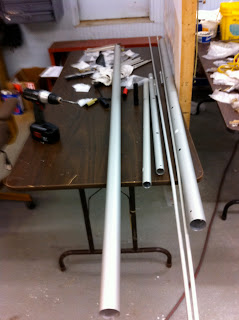The flap ribs are just 1/2 inch diameter thin wall aluminum tubing. They are inserted into a pre-cut hole in the spar and are secured from moving around by a plastic plug that is riveted from the front of the spar. In this picture I have laid out the main parts plus a tool used to hold the plastic plug in place while it is riveted. the spar shows the 1/2 inch hole opening and you can see the hole in the front of the spar for the rivet. Below the spar are the plastic plug, aluminum tube that is the rib, and another piece of tubing that will fit inside the aluminum tube to hold the river against the ID of the 2 inch diameter spar.
Here I have the rivet inserted into the hollow plug with the inner tube sticking through the rib tube. The rivet is actualy inserted from the outside of the spar.
Here it is ready for riveting. I can now press the aluminum tube and the inner tube hard against the ID of the spar while I set the rivet.
Here looking through the 1/2 inch hole in the spar you can see the plug is riveted and will stabilize the rib tube from sliding around.
And a shot of the tube sticking out of the spar prior to installing the trailling edge which kas a similar plastic plug on its outside.
Here the flaps are finished. The blue tape secures the trailing edge while I attached the root ribs. Eventually these will be covered with Poly Fiber and that tension in the fabric will hold the trailing edge on. The root ribs are fairly conventional and are riveted onto the spar and trailing edge.
Time to move back to the fuel tanks. I thought my friend Dennis was going to come over today but I never checked on his status this week. Its a good thing he didn't show because I was not quite ready. I did find enough parts to assemble the rear inspection panel and install one of the fuel sending units . I had to install some anchor nuts for this. Some of them twice since I put the wrong size on first.
I didn't get much done last week as I had to tend to Mom's hot water heater. All is fine there now. I did receive my tooling so I can press on with the center section drilling this week. More on that later.






























